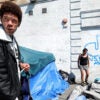High schools across America are embracing a woke curriculum. Charles Fain Lehman, adjunct fellow at the Manhattan Institute, says he is troubled by a trend in education of embracing wokeness above reason and fact.
Lehman, who is also a staff writer at The Washington Free Beacon, joins the show to discuss his recent article “American High Schools Go Woke” and how this development may affect the nation years from now.
We also cover these stories:
The Daily Signal depends on the support of readers like you. Donate now
- The Centers for Disease Control and Prevention says the length of a quarantine after exposure to the coronavirus may be shortened from 14 days to seven to 10 days.
- CDC Director Robert Redfield says America could see a massive spike in COVID-19 cases this winter.
- Sen. Ted Cruz, R-Texas, asks the Supreme Court to hear an emergency appeal on Pennsylvania’s election results.
“The Daily Signal Podcast” is available on Ricochet, Apple Podcasts, Pippa, Google Play, and Stitcher. All of our podcasts can be found at DailySignal.com/podcasts. If you like what you hear, please leave a review. You also can leave us a message at 202-608-6205 or write us at letters@dailysignal.com.
Virginia Allen: I am so pleased to welcome to the show Charles Fain Lehman, a journalist at The Washington Free Beacon and an adjunct fellow at the Manhattan Institute. Charles, thanks so much for coming on today.
Charles Fain Lehman: Thanks for having me on, Virginia. I feel glad to be here.
Allen: So today, we’re talking about a pretty popular subject, and that is woke culture. And that word, “woke,” is thrown around a lot. So I want to begin by just asking you to define exactly what we mean when we use that word, woke.
You wrote a great piece on this that we’re going to get into in just a minute, but I think it would be really helpful to start with just, what exactly do we mean by that? What does that term, woke, mean?
Lehman: Yeah, absolutely, and I think as a term, it contains contradictions or contains multitudes, as it were.
There’s an author, Wesley Yang, who I think the term is generally attributed to, but refers to what he calls the successor ideology, the ideology that comes after late 20th-century Clinton-ite, triumphalist liberalism.
And it’s really more of an inchoate thing, but it’s the set of increasingly dominant liberal-progressive ideas that really took off in the wake of Barack Obama’s reelection in 2012 when we see a lot of this churning up.
So it imports a lot of academic ideas from the 1990s and earlier, has a great deal of focus on race or critical race theory; on sex, gender, and trans issues broadly; and I think is characterized by this particular social justice outlook on how the world works. A fixation on identity categories and defining things in those terms and then defining the world as a set of struggles between those identity categories.
And also, in some senses by the degree of its interest in ideological purity, in getting people to commit themselves fully to the ideology and spurning the nonbelievers, even within their own circles.
I think most viewers, most listeners will recognize this as that increasingly dominant strain in the American left more broadly, especially the college-educated or elite left.
Allen: And you have done quite a bit of reporting on this subject. You’ve just wrote a piece called “American High Schools Go Woke.”
And in the area of education, for several years, we have seen this increase in woke curriculum being promoted, being endorsed. But after the death of George Floyd and then across the summer with protests and riots, it felt like a lot of that very, very progressive education was fast-tracked in schools.
So can you just give us an update, what exactly are we seeing now? What’s actually happening in high schools across America?
Lehman: Yeah, absolutely, and I think the first thing that I would do is I would encourage your viewers to type in the name of their local school district or type in the name of their local private school into Google with the word “anti-racism.”
And they will find almost invariably that there’s a set of resources, or [a] page, or a letter discussing the school’s commitment to the importance of anti-racism, whereby anti-racism what’s really meant is a set of particular active commitments meant to combat racism that’s distinguished from being not racist, as being a set of beliefs that are … about correcting racial injustices actively.
I think across the country, there are both private and public schools that have pushed huge quantitative of time, money, and energy into so-called anti-racist agendas since the summer, essentially.
So, for example, in my article, I looked at, on the one coast, there’s Harvard-Westlake, which is by some measures the No. 1 prep school in the United States, and they released a 20-page letter over the summer from their administrators saying, “Here’s all of the ways in which we are racist, and here are all of the steps that we’re taking to combat racism.”
For example, their 11th-grade U.S. history course is going to be overhauled to be taught from a critical race theory perspective, which means it will incorporate the latest in progressive pedagogy.
On the other coast, we at the Free Beacon have looked at Fairfax County, which is one of the collar counties of D.C. in Virginia, where they spent something like $20,000 to get Ibram Kendi, who’s a prominent race scholar, to come talk to them. This is $20,000 of taxpayer money.
I dug up the details on the Anti-Racist Reading List that was sent out to parents and students at one Fairfax area school. So really, I mean, I have identified very few schools that haven’t been touched by this stuff in some way, and they’re pushing the same ideas everywhere.
Allen: Yeah. I mean, I love the examples that you give in the article because it’s wild when you actually see what’s happening, and what’s happening not that far away.
You tell about one Connecticut prep school in your article, Loomis Chaffee, and they have introduced mandatory diversity, equality, and inclusion training for students. And they’re also requiring faculty to read Kendi’s “Stamped From the Beginning” and [Robin] DiAngelo’s “White Fragility” for what they call professional development.
So you obviously see that there is a problem here, that this kind of mandatory woke education is harmful. Why do you see it as so harmful?
Lehman: I think there are a couple of answers to that, and you can talk about what sort of ideas it’s spreading. I think that there are derogatory features of it.
If you look at responses to DiAngelo’s book, if you look at some of the more extreme instances, frankly, the accounts of race that they give are startling and disturbing.
There’s a controversy because the National Museum of American History I think over the summer released an info sheet about the norms of white culture, which implied that non-White people aren’t on time to stuff and that that’s a white norm and non-white people don’t work hard so white people are willing to work hard.
No, I believe that everyone is able to work hard. That’s an important tenant of racial equality, is that we believe that people are equal in common decency and dignity.
But I think that the other thing to highlight is that a lot of this stuff doesn’t appear to work. It doesn’t appear to have a major impact.
I think everyone can reasonably agree that if we have tools that reduce racial animosity and tension, those are good. All else equal, we want that. But there’s a reasonably strong research finding at the corporate level that the corporate diversity trainings, their primary effect is not to reduce inequality in either experience or in hiring, but actually increase racial animosity and to have no effect otherwise on who ends up in top positions.
It seems like it mostly takes some extreme example of Robin DiAngelo, if you pay somebody $20,000 to spend two hours screaming at your employees about how all of their problems are caused by racial animosity, the effect of that will be to cause them to resent each other even more, which is not really surprising.
And then I think this plays out—I highlighted in the piece a couple of different stories about progressive schools that, really, their progressivism has veered into a disturbing level of anti-Semitism.
There was reporting from Tablet Magazine looking at [a] school in New York where they divided kids out by affinity groups that were based on their ethnic identity, and how all of the Jewish kids felt super targeted by being put into the Jewish group and being told that they were terrible Zionists and … the oppression of the Palestinians, that was their fault as Jews.
So that kind of division by race, especially among high schoolers, can promote bullying and destructive behavior.
Virginia Allen: Wow. No, I mean, I think on so many levels, just fundamentally the fact that, OK why are we continuing to do things that, one, we’re seeing really don’t help, and then, two, that actually have real harmful effects?
I do want to get your opinion on something that you reference in your article. That’s the 1619 Project. We’ve talked a lot about the 1619 Project on this show, the flaws with the curriculum, but we are seeing it continue to be implemented in schools across the country.
I want to get your perspective, as a journalist, and specifically how the media reports on the 1619 Project, because we know that there flaws. The New York Times themselves, they published a major correction to the project central piece.
So why do you think so much of mainstream media just looks the other way at something that’s being so promulgated but is so clearly flawed?
Lehman: I think I want to answer that question pretty generally and then focus in on the particular example, which is that there were lots of institutions in American society today, whether it’s the Pulitzer Prize, or The New York Times, or it’s who gets the Nobel Peace Prize, which has historical legitimacy, which it did.
Their authority derives from a past treatment of authority, and which today have been more or less co-opted by partisan liberal interests. They use the stamp of their legitimacy to approve things which are ideologically correct if they’re not factually correct.
And so this is how you end up in situations, and this is when you talk with journalists specifically, where journalists are happy to pat themselves on the back with things that are factually inaccurate or which don’t set an accurate picture, but which served the ideological ends that they want them to serve. You have a laundering of legitimacy that goes on.
So I think something like 1619, the question is not, is it right? Is it presenting an accurate picture? I don’t know a huge amount about the details, but for I think your reporting on it, the question is, is this how we imagined history really looks in this Howard Zinn sense of? Is this the untold secret story of history that confirms our ideological priors?
And if the answer’s yes, then they’re going to go, “OK, this is good. And we’re going to put our stamp of approval on it, and we’re going to help advance this thing having influence in society.” That tool set is apparent across American elite society, and it’s so apparent in that case too.
Virginia Allen: Interesting. I want to dive in a little bit more into some of these examples that you give in your piece about what is happening at some of these schools.
I was really fascinated, and then I did some extra homework on it, because I was really interested, that in San Diego, their public schools have actually overhauled their traditional grading system because of racism.
So they’ve changed the way that they grade as a way to combat racism. It’s a little unclear how one plus one, not sure. They didn’t seem to draw a super direct link for how changing the grading system then will help to defeat racism in that school district. Do you know more about that situation?
Lehman: Yeah. I mean, I think, basically, one of the enduring problems in American education policy over the past 40, 50 years is that there are large and persistent gaps along race on any standardized tests that you care to name, which is to say Asian students and then white students consistently and significantly outperform Latino students and then black students, and this is called the achievement gap.
And the why is a really complicated question and there are lots of different debates about how we can address this, and I think it’s important to ask, what are the underlying causes? That might be whether there [is] socioeconomic inequality, or lack of access to resources, or lack of school choice.
There any given number of factors at play, but having observed this disparity and from beating their heads against it for the past 50 years, I think many of the most progressive figures in education policy and in teaching theory have basically said, “It’s no longer relevant to ask, ‘What is the cause of this disparity?’ We should just choose the disparities, ipso facto, racists.”
This is the … logic, “If there is a disparity, then racism is what causes it. There’s no other plausible explanation. And therefore … we should address the disparity at the level of metric.” Which is to say, “If being graded poorly on homework is the thing that is leading to the achievement gap, the measure of achievement gap on homework between black kids and white kids, then the solution is to change how we grade homework until the achievement gap goes away.”
In other words, I think their contention is that the measures are hopelessly racist and so we should change the measures.
I think my contention might be, maybe not homework, but certainly standardized testing is a reasonably good measure of something like academic ability.
And so whatever the underlying causes of the disparities, again, with racists, you can argue inequality, whatever the underlying causes of the disparities are, changing the measure to make that measured disparity go away, changing what your measure is, doesn’t actually address the inequalities or issues that are causing the disparity to emerge in the first place. But I think that’s the thinking that’s going on there.
Virginia Allen: Yeah. That seems so dangerous and obviously so not helpful to those students that are struggling that need the extra help.
I mean, I’m just thinking, for a few years you’ll have teachers and administrators thinking, “Well, we ‘fixed’ the problem,” through a bizarre solution that isn’t a solution at all, a major problem that needs to be changed probably on multiple levels to really get these students up to par and get them the help that they need.
I do want to pivot and just ask you a little bit about something that you referred to, which is director of diversity. This has become a popular job title at a number of schools. Lots of schools, lots of businesses are hiring someone that’s specifically just on staff to make sure that that community is racially aware, that they are diverse enough.
So what exactly do these people do who wear this title of something like director of diversity?
Lehman: Yeah. I mean, I think it’s a person who is responsible for, the industry buzzword is DEI—diversity, equity, and inclusion—and broadly speaking, it’s the person who is responsible for any initiatives related to those things as a set of priorities for a business, or a school, or a nonprofit, what have you.
And I think that can mean metrics for diversity, that can mean organizing a speaking event, that can mean consulting on who’s getting promoted and who isn’t. I think it’s a person who’s specifically responsible for forwarding a diversity, equity, and inclusion set of goals.
To some extent that might be good. It’s conceivable that they could do that role well. I think often in practice, that role, as I argue in the piece, often in practice what that role does is identify reasons that more diversity, equity, inclusion are needed.
So if you look at these schools, their roster of DEI people [has] only grown over the past five to 10 years. They might’ve started with one diversity chief, and then because of that person finding issues, they hire another person, and then another person, and then you have a seven-person group who’s responsible for diversity.
And it is telling to me that as these organizations add administrators, the number of acquisitions of racism only increase, the number of identified instances of racism only increase. Maybe they’re measuring better, but they may also typically be measuring more.
I think it is generally true that administrators of this sort seek in their own interest in trying to accrue, just like anybody, trying to accrue resources. And the best way to do that is to say, “Well, actually, you need even more DEI than you first thought.”
Allen: Wow, fascinating. And I know you have specifically written about that subject in other pieces, and we’ll link those in the show notes so our audience could read your work on that.
But I want to ask, apart from education, we are seeing that woke culture is really seeping into things like professional sports, of course, TV [shows] and movies, large corporations. So if we fast forward maybe 10 or 15 years, what [effect do you think] this very progressive woke culture ideology is going to have on America long term?
Lehman: I’ll say two things. One is, I’m not sure what’s going to happen in 10 to 15 years, in part because it is hard to disentangle this push for wokism and it’s contemporary political context.
Clearly, it started the second half of the Obama administration, but was empowered by the Trump administration, a liberal visceral backlash against the Trump administration. Maybe with Joe Biden in office, it’ll ratchet back. Maybe not. Who knows? Let’s imagine it doesn’t.
I think I would say, here’s the thing that’s not going to happen, I am not optimistic about the spread of woke ideology actually reducing substantive racial inequality in United States.
If our priority is doing something like reducing the black-white wealth gap, I don’t think it’s going to have a major impact on that. I don’t think Uber Eats-ing from a black-owned restaurant is going to have a major impact on that, even though they lecture me about it all the time.
I certainly don’t think you lecturing your employees about their white fragility is going to have a major impact on that. And I think in general, it is unlikely to even help diversity at the top end of the distribution. The Nasdaq can require you to have a more diverse board in order to be admitted to it, but I think companies will be really good at skirting that.
Instead, what I imagine is that mostly the serpent will leave its own tail, that as with diversity execs I talked about a minute ago, in schools, the principle applies more broadly.
What mostly will happen [is] they’ll find new ways to identify hard-to-measure racial problems, racial wrongthink, and then hire new consultants and new employees and new directors who are responsible for ferreting it out, none of which will have any interest in correcting any substantive imbalance from a policy perspective, but will instead so focus on reinforcing this idea and therefore, frankly, generating more profit for the people who propound it.
Allen: Charles, we just so appreciate your insight on this issue. I do want to ask, where can our listeners follow you, find your work?
Lehman: Absolutely. I think the best place is at the Free Beacon. That’s freebeacon.com. I’m there. All of my great colleagues are there. You can also follow me on Twitter. I’m @CharlesFLehman. … Those are both good places.
Allen: Great. Charles, thank you so much.
Lehman: Yeah. Thank you.
































